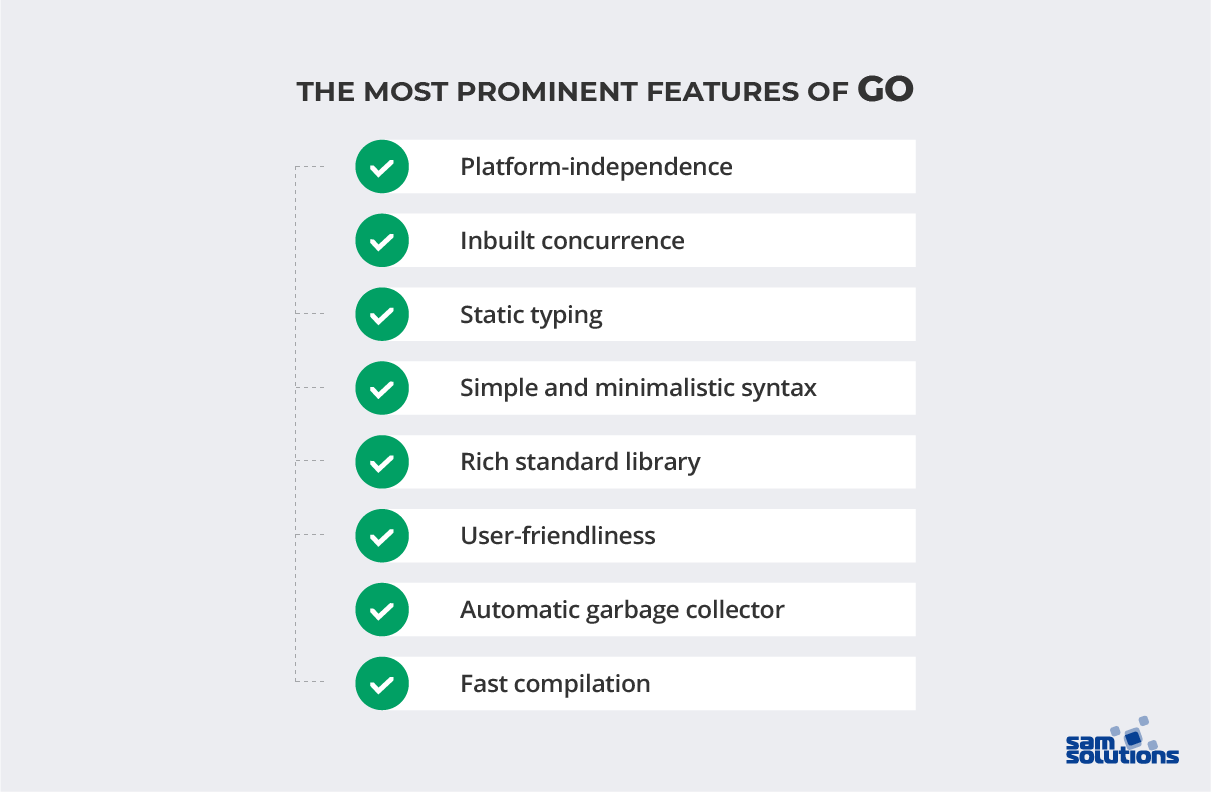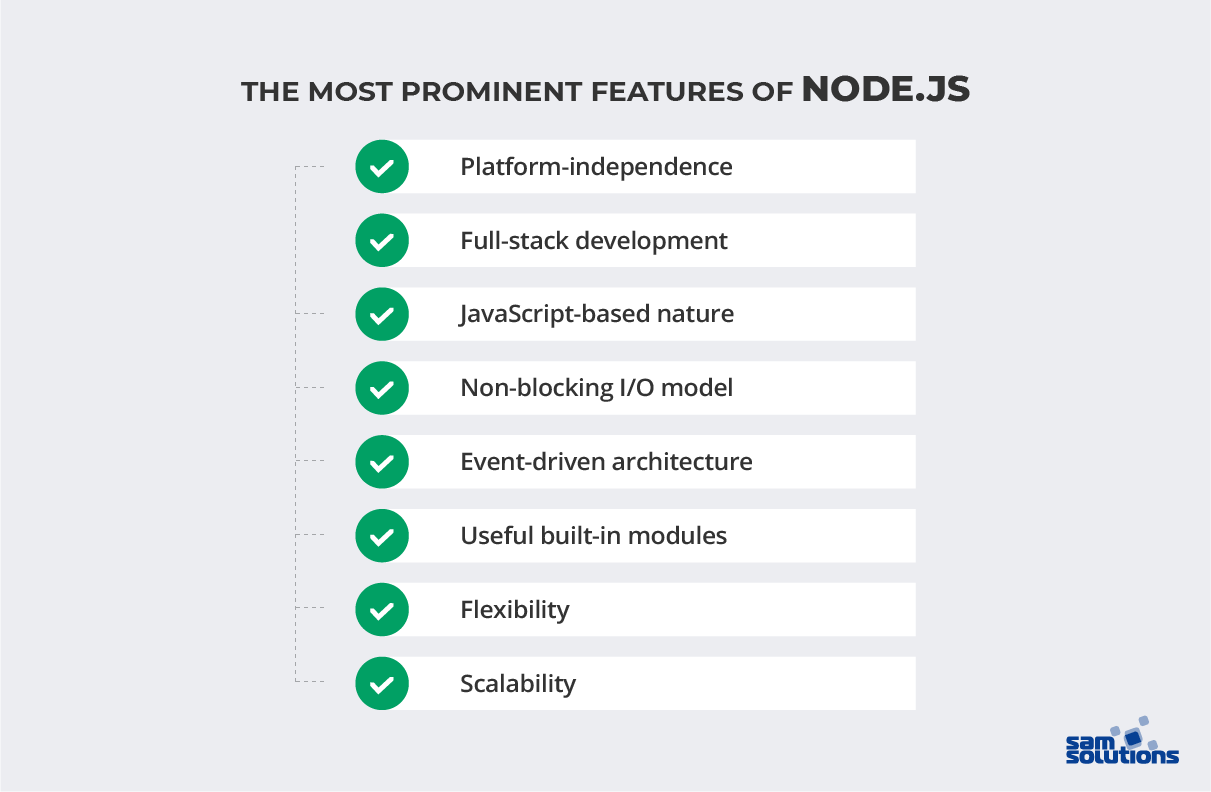Businesses are constantly looking for ways to stay ahead of the curve. But when it comes to choosing the right technology stack, making the right decision can be overwhelming. Two popular choices in the world of web development are Go and Node.js. In this article, we’ll take a closer look at the features of Golang vs Node.js, so you can make a well-considered decision.
What Is Golang?
Golang is a popular programming language developed by Google. It is a powerful compiled and statically typed language, renowned for its scalability, concurrency, high performance, memory safety and garbage collection support. With syntax similar to the C programming language, Golang was designed to be straightforward and user-friendly.
Thanks to its cross-platform nature, the Go language helps software programmers write code that can run on various platforms. It has become the language of choice for many developers in the fields of cloud computing, network programming, and distributed systems.
Develop your custom software with SaM Solutions’ engineers, skilled in the latest tech and well-versed in multiple industries.
History
The origin of Golang took place in 2007, when Robert Griesemer, Rob Pike, and Ken Thompson at Google initially developed the language. The ultimate objective of the team was to create a new programming language that could handle large-scale complex systems while still being efficient and easy to use.
The creators of Go got inspiration from other programming languages such as C, Python, and JavaScript. As a result of their work, they officially released Golang in 2009 and, since then, many businesses and developers adopted the language worldwide.

Features
Golang offers several prominent perks that make it popular among developers.
One of the most notable features of Golang is its inbuilt concurrence, which allows software engineers to write efficient code that can tackle several tasks simultaneously. As a compiled language, it also provides fast compilation so that the programmers could make quick iterations.
Go’s robust library incorporates various useful packages that help developers work more efficiently with cryptography, networks and databases. Besides, it has an automatic garbage collector, which frees the memory that is no longer in use and reduces the risk of memory leaks.
Golang is compatible with various platforms and can run on Linux, macOS, Windows, and other operating systems. It is also famous for its minimalism, which makes the development and maintenance process easier, and static typing, which helps catch and eliminate errors early in the development process.
Usage
Simple, highly performant and scalable, Golang is often used to develop software that needs to process big data and heavy traffic. For instance, Golang performance and built-in support for concurrency makes it great for such purposes as developing real-time apps, chat apps, and streaming services. The minimalistic syntax and efficiency of this language also make it ideal for cloud infrastructure, storage systems, load balancers, and serverless applications.
Moreover, Golang is a highly extensible language that offers a rich variety of development tools for projects of different business domains. For that reason, Go is highly popular for DevOps and automation tools that can optimize infrastructure management and deployment.

Companies
Uber
Uber is a transportation company with an app that provides mobility as a service, food and package delivery. The company uses Golang for its back-end development, in such areas as dispatching, payment systems, and location tracking. Thanks to Golang’s efficiency and scalability, it is an ideal choice for processing the large volumes of data that Uber deals with.
Dropbox
Dropbox is a file hosting service that offers cloud storage, file synchronization, personal cloud and client software. Dropbox uses Golang for powering its desktop client apps, back-end services, and supporting its robust network infrastructure. Golang’s fast compilation and concurrency make it an ideal choice for Dropbox’s complex cloud-based storage system.
Netflix
Netflix offers subscription-based media streaming services. The company uses Golang for its internal management tools, extensive cloud infrastructure, and, most importantly, its content delivery network (CDN). Netflix’s CDN is responsible for serving its streaming content to millions of users worldwide. Go’s concurrency model enables the CDN to handle a massive amount of data and provide a fast and reliable interface for its users.
The New York Times
Based in New York City, the New York Times is a daily newspaper with a worldwide readership. The company relied on Golang to develop its proprietary APIs, microservices architecture, and content management system (a web-based application that enables journalists and editors to create and publish content across various platforms, including the newspaper’s website and mobile apps).
Twitch
Twitch is an interactive live-streaming service that hosts gaming, entertainment, sports and music broadcasts. Go’s lightweight nature and ease of deployment make it a popular choice for building microservices, and Twitch has leveraged its capabilities to build a scalable and reliable service-oriented architecture. Twitch’s chat system is also built using Go. Again, Go’s concurrency model helps the chat system handle a large number of requests simultaneously.
Leverage SaM Solutions’ decades-long expertise in IT to develop high-quality custom software for your business.
What Is Node.js
Node.js is an open-source, cross-platform JavaScript runtime environment. In contrast to conventional web development practices, it allows software engineers to run JavaScript code on the server-side, and use it to create web applications that run outside the browser.
Node.js provides an event-driven, non-blocking I/O model, which can handle large numbers of concurrent connections efficiently. It also has an abundant ecosystem of modules and libraries that make it easy to improve Node.js performance and work with a wide range of databases and other technologies. Therefore, Node.js is also an excellent choice for building fast-performing and scalable applications.
History
Node.js has gained significant traction among developers and businesses alike since its inception in 2009. The platform was created by Ryan Dahl, who sought to harness the potential of JavaScript for both front-end and back-end web development. The concept of non-blocking I/O inspired Dahl, and he wanted to create a platform that would allow developers to build fast and scalable applications using JavaScript. He built the initial version of Node.js on top of the V8 JavaScript engine with libuv library and released it as an open-source project.
Since then, Node.js has become one of the most widely used platforms for building web applications. Its popularity has been driven by its speed, scalability, and ease of use, as well as its vibrant ecosystem of modules and libraries. Today, Node.js has abundant useful resources, ensuring its continued growth and relevance in the web development world.

Features
Node.js offers an impressive range of features that make it an attractive option for software engineers and businesses alike.
Node.js uses JavaScript, which is a familiar language for many developers. This makes it easy to transition from front-end development to back-end development, as well as to build full-stack applications using just a single language. Its platform-agnostic compatibility also allows for flexibility in deployment, running on Windows, Linux, and macOS.
Among other significant advantages of Node.js are its non-blocking I/O model and event-driven architecture. Thanks to these features, it can handle large numbers of concurrent connections efficiently and save project development time.
Finally, Node.js boasts an extensive collection of built-in modules that offer functionality for file system operations, network programming, and HTTP/HTTPS communication. It is also highly scalable, which makes it ideal for businesses that need to handle large volumes of traffic and data.
Usage
Node.js quickly gained popularity among developers working on real-time applications like chat rooms, online gaming, and streaming media. It also proved to be a valuable tool for businesses looking to develop high-performance web applications that could handle large amounts of data and traffic.
Node.js is used for a wide range of applications, from building web servers and APIs to creating web applications and microservices. Ecommerce businesses utilize Node.js for their online platforms, enabling faster and more efficient transaction processing. Furthermore, Node.js is an increasingly popular choice in the Internet of Things (IoT) industry, given its ability to handle large amounts of data and connections.

Companies
PayPal
PayPal is a leading online payment system that uses Node.js in the development of its front-end and back-end architectures. Node.js’s event-driven, non-blocking I/O model allows the company to process millions of transactions per day with ease. Node.js also powers PayPal’s service-oriented architecture (SOA), enabling it to scale quickly and efficiently.
LinkedIn, a renowned social networking platform for professionals, uses Node.js to power the backend of its mobile app. Node.js enables LinkedIn to scale its mobile applications quickly and efficiently, providing a seamless experience for users.
Another significant use of Node.js at LinkedIn is in its server-side rendering (SSR) engine, which is responsible for generating HTML content for web pages. LinkedIn’s SSR engine is built on top of Node.js, which allows LinkedIn to provide fast and performant experiences to its users while also enabling SEO-friendly web pages.
Walmart
Walmart, a multinational retail corporation, uses Node.js for its ecommerce platform. The platform handles a massive amount of data, including product listings, inventory data, and customer orders. Node.js’s asynchronous nature enables the platform to handle this data efficiently, providing fast and responsive experiences to customers.
The Walmart mobile app is also built using Node.js as the backend, allowing for fast and efficient processing of data and real-time updates to the app’s interface. Node.js’s event-driven, non-blocking I/O model enables the app to handle a large number of concurrent connections and scale quickly to meet customer demand.
NASA
One of the most notable uses of Node.js by NASA is in the development of the NASA WorldWind SDK, a virtual globe software development kit that enables developers to create applications that incorporate 3D terrain, satellite imagery, and other geospatial data. The SDK is built on top of Node.js and uses its capabilities for efficient handling of data, allowing users to explore large amounts of geospatial data in real time.
IBM
IBM, a huge international technology company, produces and sells computer hardware and software, and provides cloud computing and data analytics services. Node.js provides IBM with a flexible and modular platform for building large-scale enterprise applications, which engineers can easily integrate with other systems and services. Additionally, Node.js’ event-driven architecture enables it to handle many requests simultaneously, resulting in faster response times and better UX.
Go vs. Node.js: Comparison
| Feature | Golang | Node.js |
| Programming language | Go | JavaScript |
| Concurrency model | Concurrency primitives, Goroutines | Event-driven |
| Performance | Fast, great for CPU-bound tasks | Good for I/O operations, slower for CPU-bound tasks |
| Scalability | Excellent, due to its lightweight concurrency model | Good, with the ability to handle a large number of concurrent connections |
| Libraries and packages | Smaller ecosystem, but with a high-quality, well-documented standard library | Large ecosystem with many third-party libraries and packages available through NPM |
| Learning curve | Moderate learning curve, with some unique syntax and concepts | Easy to learn, especially for front-end developers with experience in JavaScript |
| Development speed | Fast, with a focus on simplicity and ease-of-use | Fast development cycle, thanks to the dynamic nature of JavaScript and large number of available libraries |
| Error handling | Built-in error handling mechanism, which makes error management easier and more robust | Callback-based error handling can be difficult to manage in large applications |
| Tooling | Limited tooling, with a focus on simplicity and built-in support for many features | Large number of tools and frameworks available, including Express, Meteor, and Next.js |
| Deployment | Easy to deploy, with a single binary executable that can run on any platform | Easy to deploy to cloud services like Heroku and AWS |
Node.js and Go are both powerful tools for software development, but they differ in their strengths.
Go is a fast and efficient language, ideal for CPU-bound tasks and scaling applications due to its lightweight concurrency model. Its well-documented standard library has built-in error-handling mechanisms, making error management easier. For example, developers choose Go to build web applications, networking tools, system software, and sophisticated cloud infrastructure.
On the other hand, Node.js is based on the widespread JavaScript language, therefore it has a larger user community and a more abundant ecosystem of libraries and packages. It’s great for I/O operations and handling a high volume of concurrent connections. Real-time chat apps, games and live streaming services are great examples of its implementation.
While Node.js has more tooling options, the simplicity and minimalistic syntax of Golang makes it a strong contender for building scalable high-performing applications.
Conclusion
Go and Node.js both have their own strengths but the decision ultimately comes down to what best suits your business needs. By embracing either of these technologies, you can streamline your operations, improve customer experience, and stay ahead of the competition. But while Go’s simplicity and speed make it a great choice for building powerful, scalable web applications, the flexibility of Node.js makes it ideal for building complex real-time applications.
Whichever technology you choose, make sure you have a solid understanding of its capabilities and limitations, and work with a skilled development team to ensure the success of your project. If you need extra advice on which one to choose for your project, don’t hesitate to ask our experts at SaM Solutions.



















 The Latest 15 Information Technology Trends in 2024
The Latest 15 Information Technology Trends in 2024 Top 10 Embedded Software Development Tools
Top 10 Embedded Software Development Tools IaaS vs. PaaS vs. SaaS: What’s the Difference?
IaaS vs. PaaS vs. SaaS: What’s the Difference? 10 Examples of Predictive Analytics
10 Examples of Predictive Analytics
![Web App Development Cost in 2025 [Key Price Factors]](https://www.sam-solutions.com/blog/wp-content/uploads/fly-images/31797/Web-App-Development-Cost-cover@2x-370x238.webp)











 Web App Development Cost in 2025 [Key Price Factors]
Web App Development Cost in 2025 [Key Price Factors] 13 Best React Development Tools in 2025
13 Best React Development Tools in 2025 Top 10 Mobile App Development Trends 2025
Top 10 Mobile App Development Trends 2025 Top IoT Industry Trends in 2025
Top IoT Industry Trends in 2025 Java Web App Security: Everything You Need to Know
Java Web App Security: Everything You Need to Know